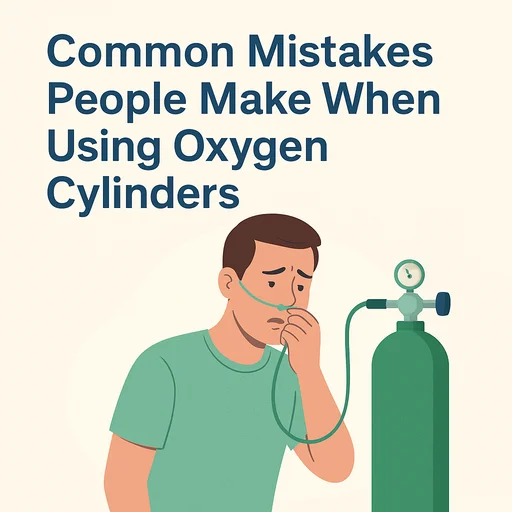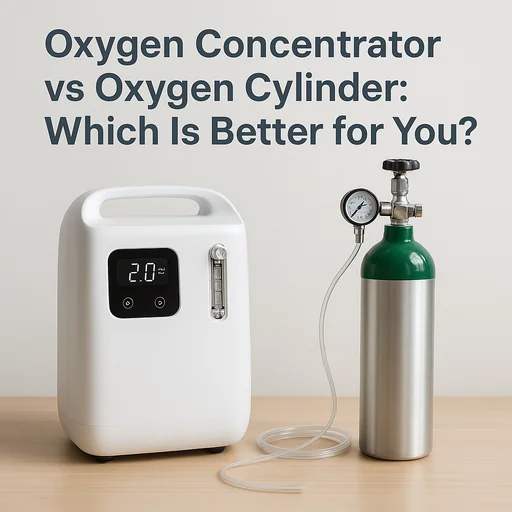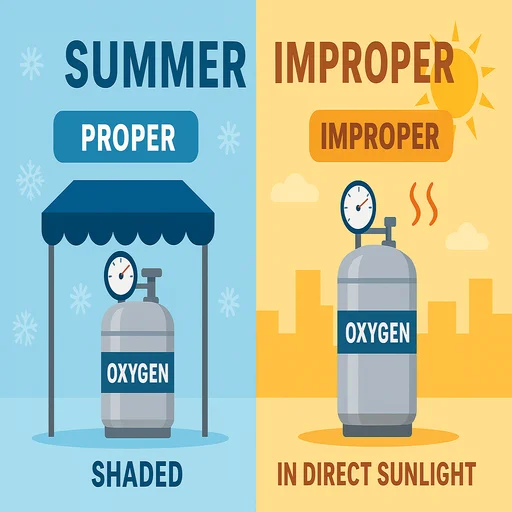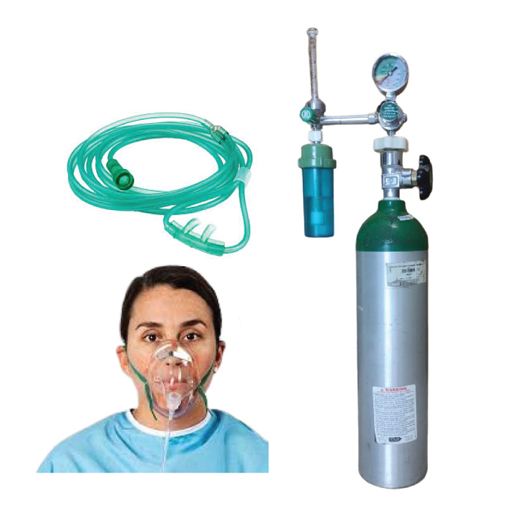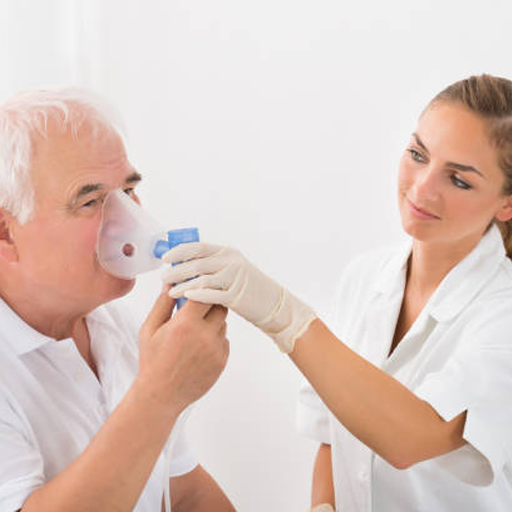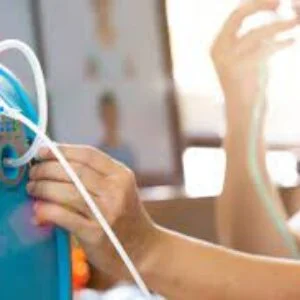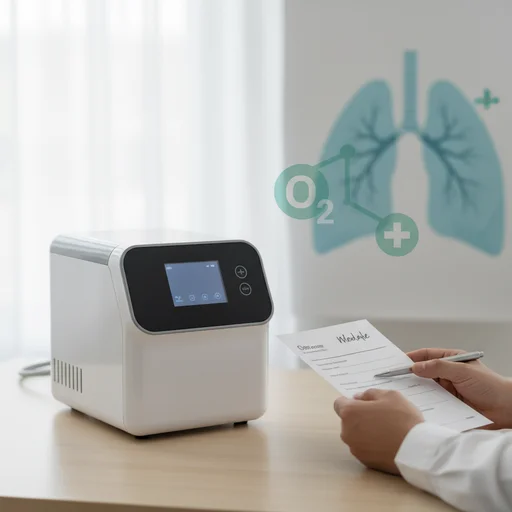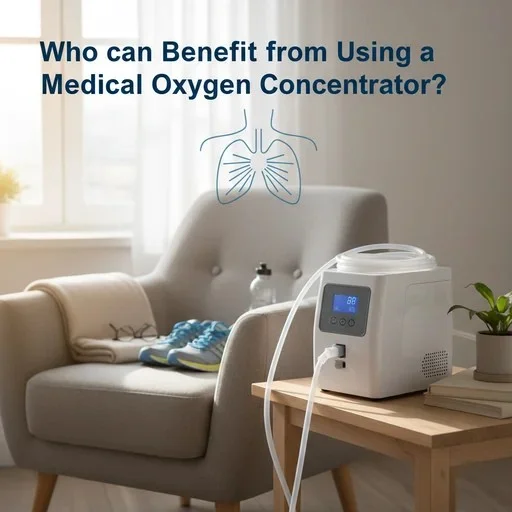Look, here’s the thing about oxygen cylinders. They seem simple enough. A tank. A valve. Some tubing. What could go wrong?
It turns out quite a lot. And most of the mistakes people make aren’t from malice or carelessness. They’re from not knowing any better. From assuming that because oxygen is natural (we breathe it all day, right?), it must be harmless, to thinking that a few shortcuts won’t hurt anyone.
Spoiler: they can.
Whether you’re caring for a loved one at home, managing a medical facility, or using supplemental oxygen yourself, understanding these common errors could literally save a life. Let’s talk about what goes wrong and how to fix it.
Mistake #1: Treating Oxygen Like It’s Just Air
This is the big one. The mistake that underlies almost every other mistake.
Oxygen isn’t just air. Materials burn much faster in oxygen-enriched environments, and things that wouldn’t usually catch fire suddenly become dangerous fuel sources. Your cotton bedsheets? Fire hazard. That hand lotion you’ve been using for years? Potential ignition source if it’s petroleum-based.
People forget this. They treat their oxygen cylinder like any other piece of medical equipment, when really, it’s more like having a controlled accelerant in your home.
Here’s what happens: materials that are slow to ignite or won’t burn in air will ignite and burn in an oxygen-rich environment. That sweater that would normally smolder? It’ll go up in flames. That’s not an exaggeration. That’s chemistry.
Mistake #2: Smoking or Allowing Smoking Near Oxygen
This one would be obvious. And yet…
Home oxygen therapy is not indicated in patients who continue smoking because of the significant risk of fire. It’s actually considered an absolute contraindication. Not a suggestion. Not a recommendation. A hard stop.
But people rationalize it. “I’ll just step outside.” “I’ll turn the oxygen off first.” “The cigarette is across the room.”
None of that matters. Oxygen saturates into surgical drapes, bed sheets, clothing, and other materials. Your clothes are holding onto that oxygen even after you turn off the flow. One spark, one ember, one careless moment… and the consequences can be catastrophic.
If you or someone you care for can’t quit smoking, talk to your doctor. There are smoking cessation programs. There are alternatives. What you can’t do is gamble with fire while using oxygen therapy.
Mistake #3: Using the Wrong Products on Your Skin
Quick question: what’s in your moisturizer?
Suppose it’s petroleum jelly, baby oil, or anything petroleum-based. In that case, you need to stop using it immediately while on oxygen therapy. Petroleum-based creams and lotions should not be used on the face or upper body when oxygen is in use.
The same goes for alcohol-based hand sanitizers. Sure, they’re everywhere now (thank you, pandemic). Still, you shouldn’t use them unless you thoroughly rub them into your skin and let your hands dry completely before handling oxygen equipment.
The problem? These products are flammable. And in an oxygen-enriched environment, “flammable” becomes “extremely flammable.”
Water-based products are fine. Ask your doctor or respiratory therapist for recommendations. Your skin might be a little drier than you’d like, but dry skin is better than burns.
Mistake #4: Improper Storage and Handling
Oxygen cylinders aren’t luggage. You can’t just toss them in the trunk, lay them on their side, or leave them rolling around unsecured.
Cylinders must be kept upright and restrained at all times. Always. Whether they’re in storage, in use, or being transported. The reason? A falling cylinder can become damaged, and a fractured cylinder with escaping gas can propel the cylinder with enough force to penetrate cinder block walls.
Yes, really. Your oxygen cylinder could become a missile.
Storage matters too. Oxygen cylinders must be separated from flammable gases or combustible materials by at least 20 feet or by a fire-rated wall. Don’t store them in closets, trunks, or anywhere with poor ventilation. Don’t lay them on their side. Don’t forget to close the valve when they’re not in use.
At Marium Oxygen, we ensure our delivery partners assist with proper installation and placement. But once they leave, the responsibility falls on you.
Mistake #5: Opening Valves Too Quickly
There’s a right way and a wrong way to open an oxygen cylinder valve. Most people don’t know there’s a difference.
Fast pressurization can create sufficient heat to ignite certain materials and cause a fire. That’s why you’re supposed to stand to one side of the outlet when opening the cylinder valve and open it slowly.
Before connecting a regulator, you should also “crack” the valve… open it briefly for just an instant to clear any debris, then close it again. This prevents contamination from entering the system.
Never use tools like hammers or wrenches to force a valve open. If it won’t open by hand, the cylinder needs to go back to the supplier. Don’t improvise. Please don’t force it. That’s how accidents happen.
Mistake #6: Ignoring Prescribed Flow Rates
Your doctor prescribed a specific flow rate for a reason. It’s not a suggestion. It’s not a starting point for you to adjust based on how you feel.
Taking in more oxygen than your body needs can slow your breathing and heart rate to dangerous levels. Too much oxygen can lead to oxygen toxicity, especially in patients with conditions like COPD. Patients with COPD who receive too much oxygen face risks of hypoventilation that can lead to apnea.
On the flip side, some people reduce their oxygen flow, thinking they’re conserving supply. That’s equally dangerous. Your body needs what it needs.
Check your flow meter regularly. Make sure it’s set correctly. If you feel like you’re not getting enough oxygen or you’re getting too much, call your doctor. Don’t adjust it yourself.
Mistake #7: Poor Maintenance and Equipment Checks
When was the last time you cleaned your nasal cannula? Checked your tubing for cracks? Tested your backup tank?
Most people don’t have good answers to these questions. They use their oxygen equipment every day and never think about maintenance until something goes wrong.
Oxygen tubing should be checked for cracks and leaks, and nasal prongs should be cleaned daily. You should also monitor your tank’s pressure gauge and give yourself plenty of time to arrange refills or exchanges. Running out of oxygen because you didn’t check the gauge isn’t just inconvenient; it’s dangerous. It’s dangerous.
If you’re using an oxygen concentrator, keep it several inches away from walls and never place anything on top of it. Make sure alarm systems are working. Clean filters according to the manufacturer’s instructions.
At Marium Oxygen, we offer 24/7 customer support precisely because equipment issues can happen at any time. We also provide refills and maintenance services. But you need to know when to call.
Mistake #8: Using Oxygen Near Heat Sources
This seems like common sense, but it happens more often than you’d think.
Keep heat sources and flames at least five feet away from where your oxygen unit is used or stored. That includes stoves, heaters, fireplaces, candles, and even electrical appliances like hair dryers and heating pads.
Don’t use oxygen while cooking with gas. If you need continuous supplemental oxygen, make arrangements. Use a portable oxygen concentrator that allows you to move to a safer distance. Have someone else do the cooking. Just don’t stand over a gas stove while oxygen is flowing.
And here’s one people don’t think about: never leave portable oxygen in a car parked in the hot sun. Heat plus pressurized oxygen is a recipe for disaster.
Mistake #9: Not Having Emergency Plans
What happens if there’s a power outage and you’re using an electric oxygen concentrator? What if you drop your tank and damage the valve? What if there’s a fire?
Too many people don’t have answers to these questions until they’re facing an emergency.
You need backup equipment. Have a backup oxygen tank and notify your power company that you have life-sustaining equipment in your home. Consider getting a backup generator. Have working smoke detectors and fire extinguishers throughout your home.
Post “No Smoking” and “Oxygen in Use” signs. Make sure family members and visitors understand the rules. Notify your local fire department that you’re using oxygen at home.
In Bangladesh, particularly in Dhaka, where we operate at Marium Oxygen, power interruptions can occur. That’s why we emphasize having backup systems and why our 60-minute delivery service exists. Oxygen emergencies don’t wait for convenient hours.
Mistake #10: Contaminating Equipment with Oil or Grease
This is more common in industrial settings, but it also happens in home use.
Oils and greases become hazardous when exposed to oxygen. They can cause spontaneous combustion. Oil or grease should never be used on connections to an oxygen cylinder or gas line.
Don’t try to lubricate sticky valves. Don’t use oily rags near oxygen equipment. Keep your hands clean of grease or oil before handling your oxygen system. If a valve is stuck or a connection seems tight, that’s not a lubrication problem. That’s a “call your supplier” problem.
The Bigger Picture
These mistakes share a common thread. They come from underestimating oxygen.
It’s easy to forget that you’re dealing with a powerful oxidizer. Easy to get comfortable with the equipment you use every day. Easy to think, “just this once won’t hurt.”
But oxygen doesn’t care about your intentions. It doesn’t make exceptions. And the consequences of these mistakes range from equipment damage to serious injury to death.
The good news? Every single one of these mistakes is preventable. It just takes knowledge, attention, and respect for what you’re working with.
If you’re new to oxygen therapy, take the time to learn correctly. Ask questions. Read the manuals. Talk to your respiratory therapist. If you’re caring for someone using oxygen, make sure you understand the safety protocols. If you’re a healthcare provider or facility manager, ensure your staff receives proper training.
And suppose you’re in Dhaka or anywhere in Bangladesh and need oxygen supplies, equipment, or have questions. In that case, Marium Oxygen is here to help. We’re government-approved, we deliver fast, and we understand that this isn’t just about equipment. It’s about keeping people safe.
Because at the end of the day, oxygen therapy is a life-sustaining treatment. It deserves to be treated seriously. Your life, or the life of someone you love, might depend on it.

